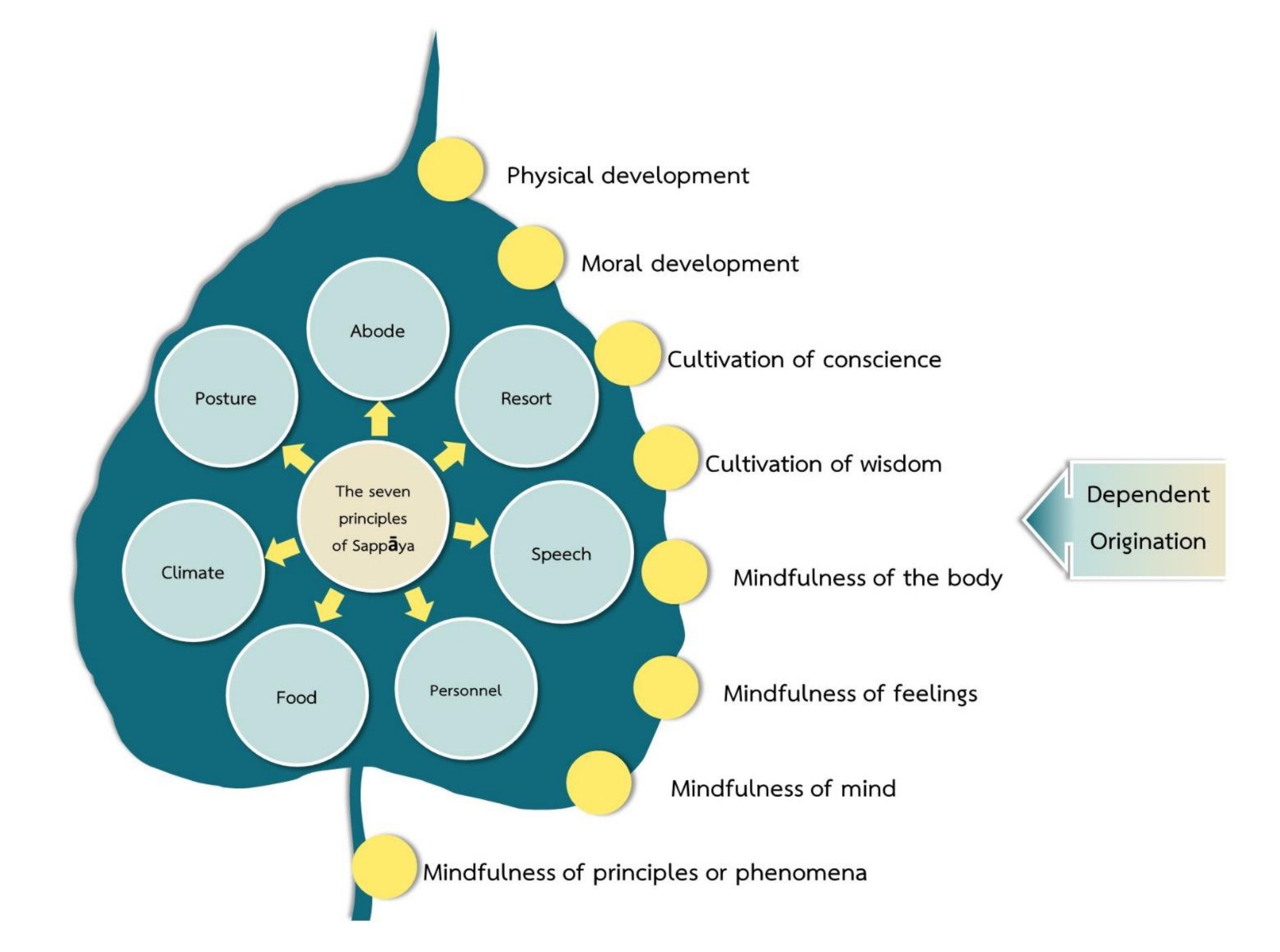AN APPLICATION OF THE SEVEN PRINCIPLES OF SAPPĀYA IN THE DEVELOPMENT OF WAT BANG WONG IN THUNG YAI DISTRICT, NAKHON SI THAMMARAT PROVINCE
Keywords:
Application, The Seven Principles of Sappāya, Development, Wat Bang Wong, Nakhon Si Thammarat ProvinceAbstract
Background and Objectives: Buddhist temples require the necessary measures to defend themselves from complications in the transitional social environment, politics, and economy. The development of Buddhist temples requires seven principles of Sappāya to make temples that satisfy and build faith in people along with renovate constantly. The objectives of this research article are for studying the concept of temple development with the seven principles of Sappāya, studying the seven principles of Sappāya that appear in the Theravada Buddhist scriptures, and applying the seven principles of Sappāya in the development of Wat Bang Wong in Thung Yai District, Nakhon Si Thammarat Province.
Methodology: This research was qualitative research that collected data from relevant documents and in - depth interviews.
Main Results: The research finding indicated: 1) The results of the study of the concept of temple development with the seven principles of Sappāya indicated that the most advantageous factor was citizen participation which meant that it was a collaborative learning process that created a solid foundation for local sovereignty. 2) The study on the seven principles of Sappāya indicated that the seven principles of Sappāya that appeared in the Theravada Buddhist scriptures consisted of 2.1) Āvāsa - sappāya meant living in a suitable abode, 2.2) Gocara - sappāya meant living in an accessible area, 2.3) Bhassa-sappāya meant living with community members who conducted conversations that supported meditation, 2.4) Puggala-sappāya meant living with personnel who conducted in approachable manners for conversations in Dhamma, 2.5) Bhojana-sappāya meant being around the source of food and medicine, 2.6) Utu-sappāya meant living in a suitable climate, and 2.7) Iriyāpatha-sappāya meant being surrounded by religious and intellectuals. 3) Application of the seven principles of Sappāya in the development of Bang Wong Temple enabled Wat Bang Wong to be a more worshiped and acknowledged temple for people.
Involvement to Buddhadhamma: The application of the seven principles of Sappāya to develop Wat Bang Wong is the relevance in the characteristics of Applied Buddhism. The adaptation of the seven principles of Sappāya to develop the temple indicates: 1) The aspect of the abode, a conceptual framework and direction in facility construction should exist; 2) The aspect of the resort, the temple should manage the temple to be in a location that is accessible; 3) The aspect of the speech, community members should conduct conversations with pragmatic dialogues than nonsensicality; 4) The aspect of personnel, personnel in the temple should conduct with virtues, worthiness, approachability to conduct Dhamma conversation; 5) The aspect of food, consumables both inside and around the temple must adhere to the standard of correct nutrition, be healthy, and be suitable for Buddhist monks and meditation practitioners; 6) The aspect of the climate, the temple must locate in a suitable weathering area, which must conduct forestation to provide a restorative atmosphere; 7) The aspect of posture, the meditation sessions of monks and meditation practitioners must operate within appropriate welfare.
Conclusions: The seven principles of Sappāya were factors of practical education that contributed to welfare and personal development. The seven principles of Sappāya were appropriate factors of people development to receive preferable results and assist people to gain steadfast prosperity, not to deteriorate, they encouraged facilities and individuals to be comfortable and suitable for asceticism and wisdom preservation, they briefly comprised an abode near the alms routes, pragmatic dialogues among peers, persons who influenced peace of mind, nutritious foods, a suitable climate, and a posture that supported tranquility and serenity within the organization.
References
Cronbach, L. J. (1970). Essentials of Psychological Test (5th ed.). Harper Collins.
Department of Public Affairs, Sangha Sangha Association. (2020). Handbook and Practice Guidelines for Pracharat Temple Project, Create Happiness. Printing Rules.
Hinsui, J. & Mongkolsrisawat, S. (2014). Guidelines for promotion of Buddhist Tourism: A case study of Prachakumwanaram temple, Srisomdet, Roi-et province. International Thai Tourism Journal, 10(1), 50-58.
Mahachulalongkornrajavidyalaya University. (1996). Tipitaka in Pali language. (Mahachula Tepitaka Edition 1957). Mahachulalongkornrajavidyalaya University Printing House.
Phrakru Sophonphuttarak Dhammaraso, Phramaha Duangden Thitayano & Wattanapradit, K. (2017). An Application of the Seven Sappaya for Developing Meditation Instructor Course 39 Willpower Institute Branch 73 Wat Pra-Ngam, Trang Province. Journal of MCU Peace Studies, 5(2), 260-272.
Phramaha Somthawin Pabhaso. (2018). Administration of Meditation Centers in Bangkok in accordance with Sappãya VII. [Unpublished master's thesis]. The Requirement for the Degree of Master of Arts (Buddhist Educational Administration) Mahachulalongkornrajavidyalaya University.
Phra Phonchart Buddhasaro. (2018). A Study of Suitable Things for the Dhamma Practice of the Dhamma Practice Retreat in Surin Province. [Unpublished master's thesis]. The Requirement for the Degree of Master of Arts (Buddhist Studies) Mahachulalongkornrajavidyalaya University.
Phra Weerasak Jayadhammo. (2014). The ways of the management in buddhist temples for peace according to the seven‘sappaya’: the case study of wat thannamlai (suanmokkhaphalarama) in lamet sub-district, chaiya district, suratthani province. [Unpublished master's thesis]. The Requirement for the Degree of Master of Arts (Peace Studies) Mahachulalongkorn rajavidyalaya University.
Public Affairs Department, Sangha Council. (2020). Guidelines and guidelines for Wat Pracharat project to create happiness. NITI printing.
Royal Academy. (2003). Royal Institute Dictionary 1999. Nanmee Books Company Limited.
Talobtong, P. (2021). Driving the Wat (temple), Pracha (people), Rat (State) for Happiness Creation Projectof the Sangha in Nakhon Sawan Province. Journal of Roi Kaensarn Academi, 7(2), 83-96.
Thai Health Promotion Foundation (Thai Health). (2016). Happy World Temple of Sappaya. Wat Sang Suk Project Technology Promotion Association (Thai-Japanese).

Downloads
Published
How to Cite
Issue
Section
License
Copyright (c) 2023 Journal of Buddhist Anthropology

This work is licensed under a Creative Commons Attribution-NonCommercial-NoDerivatives 4.0 International License.







